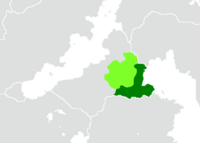Duchy of Yugstran
Duchy of Yugstran Yugstran | |||||||||
|---|---|---|---|---|---|---|---|---|---|
| 1023–1919 | |||||||||
|
Battle standard of Yugstran | |||||||||
 Yugstran at its maximal extent in the Velikoslavian Empire | |||||||||
| Status | Principality | ||||||||
| Religion | Aletheic Church | ||||||||
| Tartoman | |||||||||
• 1023 - 1045 | Yarvos I | ||||||||
• 1250 - 1292 | Kando II | ||||||||
• | ... | ||||||||
| History | |||||||||
• Ikonkivoyra | 1023 | ||||||||
| 1919 | |||||||||
| |||||||||
The Duchy of Yugstran was one of the two major kingdoms fighting during the Long Ikonkivoyra. Following the murder of Havar in 1020, count Yarvos of Yugstran became the de-facto leader of the iconodudlist resistance against the Sevromark. Instead of proclaiming himself King, like his rival Karro did, Yarvos instead upgraded his realm to a Duchy for both political and ideological reasons.
Before the Ikonkivoyra, Yugstran was considered to be a second-tier territory inside the Kingdom of the Drev, overshadowed by the Duchy of Vizstran which was the real power on the right side of the Drev river, it's dukes being the real leaders of the Iconodulists Orthodoxs.
The history of Yugstran is traditionaly divided in three era: the Ikonkivoyra, the Veliko-Azari vasselage, and the Triple-Crown. It was dissolved in 1919 with the abolition of the monarchy.
History
Ikonkivoyra
During the Ikonkivoyra, the Grand Duchy was in a state of war against the Sevromark and was slowly pushed eastward by the latter, losing its original lands south of the Drev and in the Yug and Viz bassins, but gaining the control of the eastern coast after a serie of successful campaigns. Despite its rather large armies and the existence of a permanent tax, the administrative reliance on feudal lords and the weakness of the central government permanently shaken by court intrigues left the Duchy struggling to survive, owning its successes to an handful of generals acting as independent rivals of the Court and thus were as much dangers for the Dukes as they were for their ennemies. Yugstran won the war only through the help of the Kingdom of Azarija which intervened in their favour in exchange of the Duke's submission. Under this agreement, the Duchy reached its maximal extend, recovering all of its lost territories and gaining some more, and its Duke also gained the title of "Regent of Drevstran" from their new master. When Azarija was conquered by Velikoslavia in the 16th century, the duchy was integrated into the empire as well giving it direct access to Periclean Sea.
Veliko-Azari Vasselage
Succession War
As the domination of Velikoslavia over its southernmost principality weakened, the Duchy and its Ban of Drevstran became a point of friction between the Lushyodorstag and the Emperor. This culminated in 1690 with the Duke's death and the succession war fought by the two main claimants : Farza IV and Yaropolik. The death of Yaropolik at the battle of Angrast in 1694 and the convertion of Farza IV to the Aletheic Church marked the start of a personal union between the Lushyodorstag and Yugstran known as the Triple Crown.
Culture and economy
The early culture of Yugstran was characterized by a strong reaction to iconoclasm with a rapid development of Icons and of the spread of relics. The lack of control over the Drev river also led to the duchy relying on maritime trade to develop its economy.
By the time Yugstran became part of Azarija and then Velikoslavia, it had become an essentially marine state, turned toward the Periclean. It had developped a strong icon-making religious culture based on the Aletheic faith. It retained its own Archpresbytership under the larger Velik Communion, a religious union that remain to this day despite the adoption by Archpresbytership of the Drev of the Oecumenic Bible under the Triple-Crown.